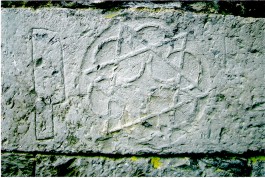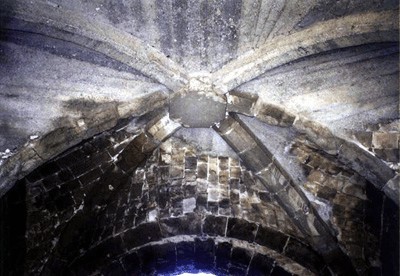
| Readers' Queries Online |
|---|
![]() Have been an avid on-line reader of Nexus
since I visited Roncesvalles several years ago & spotted
a geometrical relief on a stone in a wall there. So far as I
have been able to find, there has been no discussion of this
geometry, which looks like a medieval mason's work. I can see
the circle geometry and guess that there is square geometry there
too. What seems to be a mason's square is carved beside the geometry.
Have been an avid on-line reader of Nexus
since I visited Roncesvalles several years ago & spotted
a geometrical relief on a stone in a wall there. So far as I
have been able to find, there has been no discussion of this
geometry, which looks like a medieval mason's work. I can see
the circle geometry and guess that there is square geometry there
too. What seems to be a mason's square is carved beside the geometry.
I have a question for the Nexus
readers: "Are there any relationships between architecture
and higher mathematics?" By "higher" I
mean, mathematics at the level of 1st master and up. The topology
paper goes in that direction, but the reason why I propose it
is different: I recently wrote a paper (in Dutch) on "Africa
and higher mathematics". "True, die-hard" mathematicians
sometimes take architectural math as "baby math", and
of course, related to Africa, there are some down-to-earth social
(extremist) influences involved. Nevertheless, in the architecture
case, the question could be seen as a modification of Mario Salvadori's
query.
Read
the responses...
I would like to propose a topic for your
"query". Last October, I visited an old church in Zsambek,
Hungary. Apart from the turbulent history of the place, and the
church in particular, there was something special with some arcs,
as shown
in this picture:
Well now, Kim, is this a good
start for a Nexus discussion with your readers? Maybe it is even
a good idea for a new Nexus column "I have seen this, but
what (the hell) was it?"
Read
the responses...
Do any contemporary
architects understand enough about mathematics (beyond additive
planning and accidental occurrences) to apply it in their work?
And even if they did, why should they do so, given the collapse
of ancient mimesis and related understanding until the 18th century,
which was the foundation of such applications in the past?
While I recognise that I have
adopted a very negative view, I should like to be proved wrong,
as the question is most interesting and provocative!
Read the
responses...
In your opinion, what living
architects show the greatest use of mathematics in their designs?
Can you cite a building by one or more that shows this? If you
could interview these architects, what question or questions
would you ask?
Read the responses...
Something that has always interested me is the orientation of buildings. According to the excellent illustrated book, CITY: A story of Roman Planning and Construction, by David Macaulay 1974 (I have a Japanese version at hand), there is a priest who sacrifices a pheasant and a rabbit and checks their liver to find out if the area is suitable for living. My questions:
- Was this all religious (genius loci related?) or was it scientific in a way that checking the liver revealed the soil and chemical pollutants of the area?
- Where was this altar in the center of the later Roman grid city? ( in the forum where via principatis meets via praetoria)
There must
be a reason why the Colosseum and other amphitheatres are elliptical
in plan, while their derivations -- the Iberian bull-fighting
arenas, and the modern circus -- are circular, and the Roman
theatres are semi-circular. I can't remember having seen any
explanation in the literature. And -- are they true ellipses,
or made up from circle arcs of different radii?
Read
the responses...
To the optimist, the glass is
half full.
To the pessimist, the glass is half empty.
To the architect, the glass is not big enough.
To the NNJ reader, the glass will be the subject of his (or her) next presentation at the Nexus 2004 conference.
Would anyone like to add to the
list?
Read
the responses...
Following Frank Lloyd Wright's
influence on twentieth century architecture, one can trace a
path from his immediate draftsmen in Oak Park, to the Prairie
School in general, to the young European Modernists, to the Taliesin
Apprenticeship and FLW School of Architecture. I would like to
follow that path of Wright's design language of geometry and
its impact on late twentieth and current twenty-first century
architectural practice. Can the NNJ readership help in formulating
a list of architects who have been influenced by Wright's geometry?
Read the responses...
I have noticed, possibly largely
from those more mathematically inclined, the tendency to limit
one's inquiry to the question of "how". What Professor
Shneider of University of Colorado meant by distinguishing "reasoning"
from "problem-solving" during the Nexus 2002 round-table,
the point Dr. Perez-Gomez has made in years in his work in theory,
and what Dr. Tavernor pointed out by "quality"
as distinguished from "quantity" all point to yet
another kind of inquiry, that is, the question of "why".
"Why is mathematics used in architecture?" or
"Why is this particular mathematics appear in this piece
of architecture?", as opposed to "How mathematics is
used in architecture?", provides another important aspect
of the subject. Expanding on the questions regarding of "why"
will, I think, allow us to go beyond the surface of form and
structure making, and toward the understanding of the ideas and
the ideals that have supported architecture.
Read the responses...
In the
Nexus 2002 round table discussion, Robert Tavernor said that
in his Ten Books on Architecture Leon Battista Alberti
writes about both the quantity and the quality
of numbers. To quote Tavernor, "Thus, [Alberti] talks about
the importance of measuring buildings, of the experience
of measuring buildings, so that there is that one-to-one relation
with things: that numbers are not just abstract things, they
describe qualities too. And he particularly talks about the quality
of number in a universal sense, in terms of its relationship
to ourselves and the meaning of number beyond ourselves. So I
think it's very difficult to teach mathematics to architects
today without also emphasising the quality of number. Understanding
these qualities comes only through experience." Can anyone
explain exactly what might be meant by the "quality"
of number?
Read
the reponses...
While to
track the first rectangular or square plan would be almost impossible,
in the case of circular plans we have Stonehenge (England) or
Cuicuilco (México) as the possible firsts - or at least
the earliest examples - of such genre.
What
is it the first example - or at least the early ones - for a
triangular architectural plan?
Read
the responses...
It appears that the first pointed arch
in Europe may have appeared in Sicily around 1130. In 1090 in
Sicily there are no pointed arches; in 1130 there are. The first
crusade dates from 1099. It may be logical to think that pointed
arches were a result of the crusade.
Does anyone
know what the first pointed arches were in Europe, and if there
were any earlier than the Sicilian ones of 1130?
Read the reponses...


Copyright ©2006 Kim Williams Books

